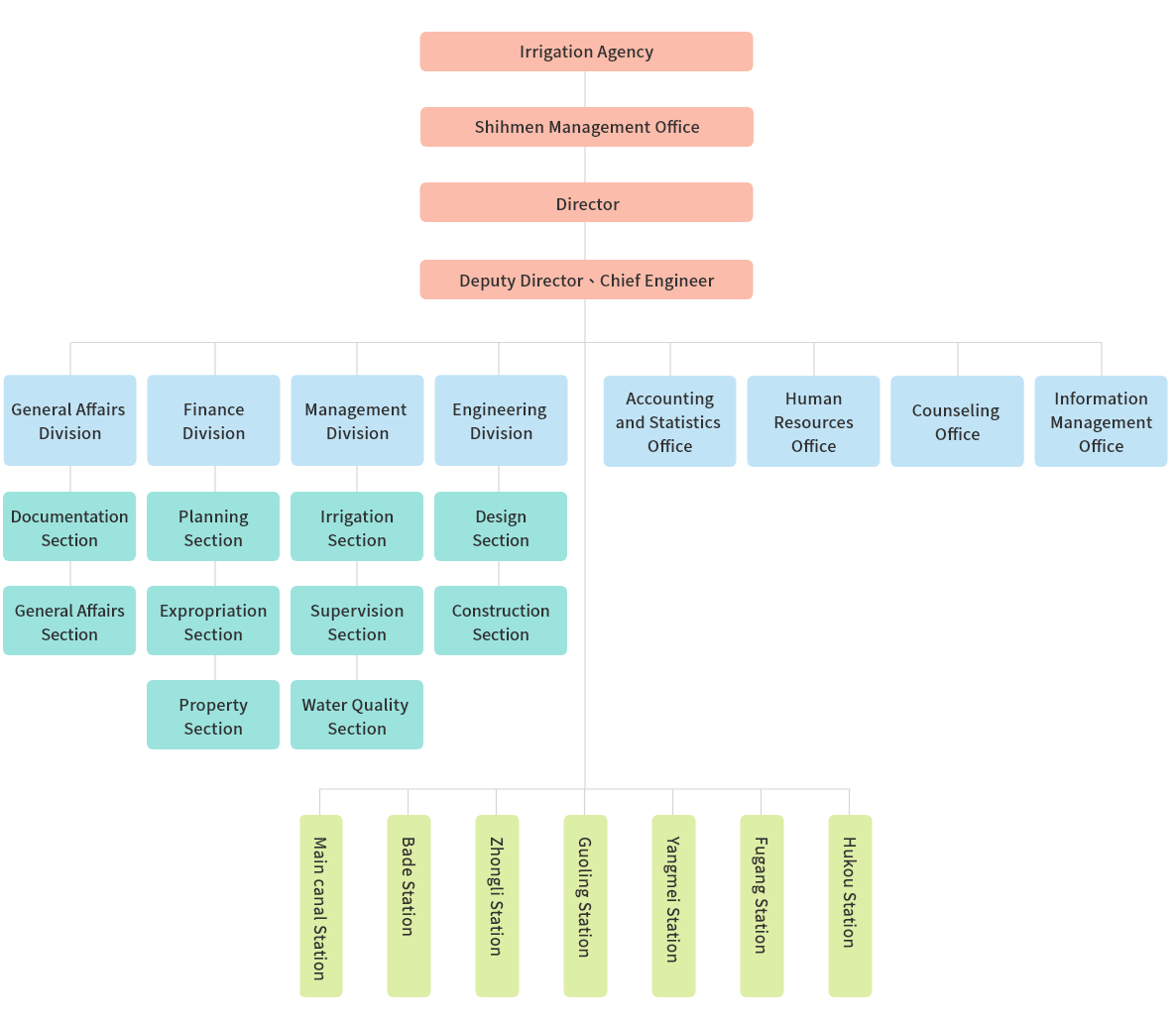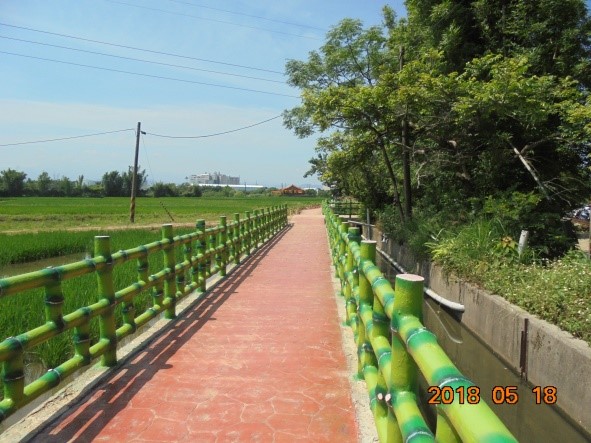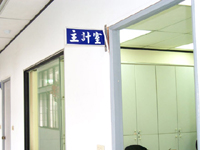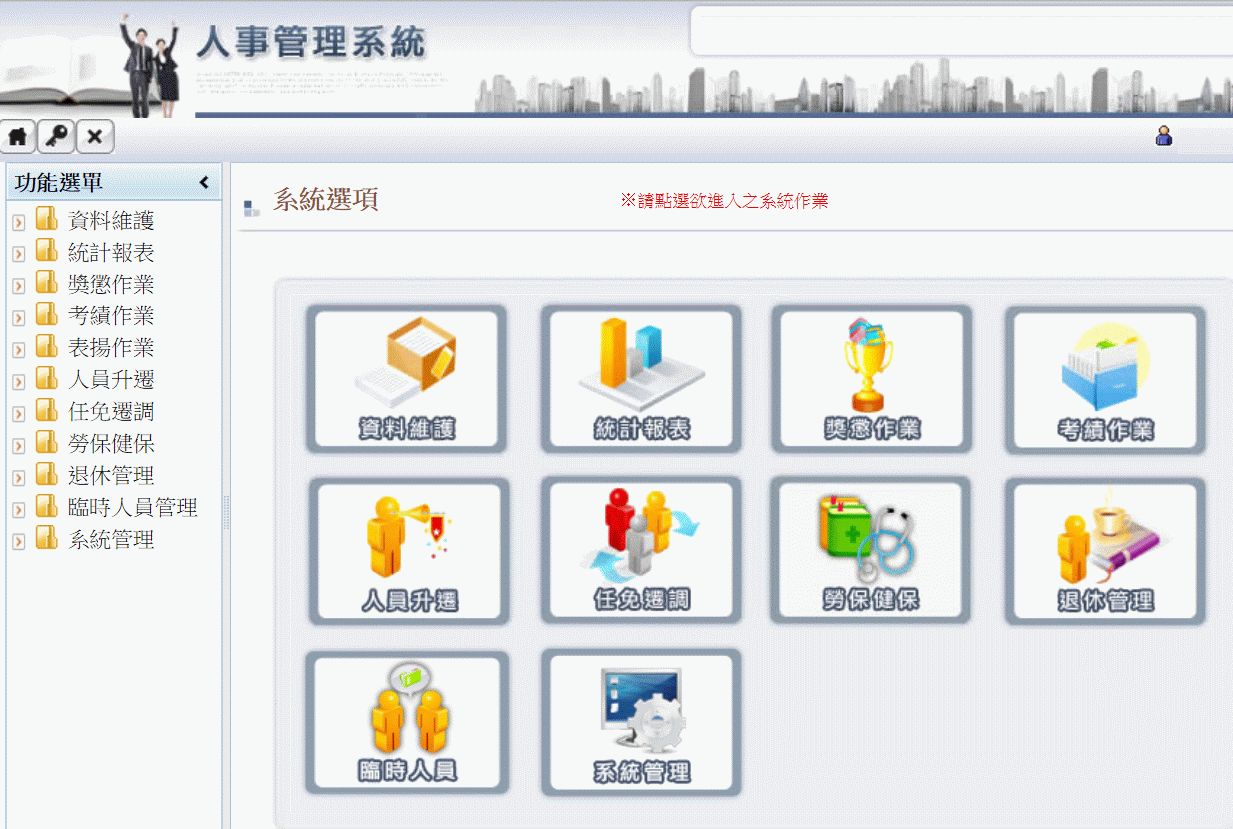
The organizational structure of Shihmen Management Office, Irrigation Agency from top to bottom includes:
1 Director, 1 Deputy Director, and 1 Chief Engineer. There are also the General Affairs Division, Finance Division, Management Division, Engineering Division, Accounting and Statistics Office, Human Resources Office, Counseling Office, and Information Management Office.
The General Affairs Division includes the Documentation Section and General Affairs Section. The Finance Division includes the Planning Section, Expropriation Section, and Property Section. The Management Division includes the Irrigation Section, Supervision Section, and Water Quality Section. The Engineering Division includes the Design Section and Construction Section.
There are also affiliated stations, including the Main canal Station, Bade Station, Zhongli Station, Guoling Station, Yangmei Station, Fugang Station, and Hukou Station.
The Engineering Division is divided into the Design Section and the Construction Section. It is responsible for updating and improving water conservancy facilities, disaster repairs, and various engineering tasks, including planning, surveying, design, bidding, inspection, construction, and acceptance.
To implement a three-tier quality control system, enable occupational safety and health management, ensure construction quality, and prevent engineering defects, a five-member supervisory team for improvement projects, led by the Chief Engineer, was formed. This team conducts random inspections and supervises various construction projects to ensure high-quality execution.


In line with the principles of quality control and efficiency enhancement, the office actively carries out annual updates and improvements to water conservancy facilities.



To effectively maintain ecological balance, beautify the environment, and enhance the quality of life for residents around water conservancy facilities, our office has actively conducted greening and beautification projects for irrigation channels and ponds. This includes renovating old and damaged canal and pond embankments and surrounding areas to improve irrigation efficiency. The office also plants flowers and trees and installs recreational facilities such as walkways and simple pavilions, effectively regulating irrigation water for farmers while providing nearby residents with leisure spaces.


- Registration and extension of agricultural water rights and management of water rights certificates.
- Planning, allocation, regulation, and management of irrigation water.
- Planning of irrigation and drainage systems as well as management and enforcement of irrigation and drainage order.
- Preparation of irrigation records and reports, and supervision of irrigation survey changes and registrations.
- Guidance on irrigation technology experiments, research, and reporting, and promotion of technical improvements.
- Monitoring and statistical analysis of water usage, water losses caused by pond and canal siltation and leakage, and drainage functions.
- Adjustment and planning of irrigation systems.
- Research and implementation of land improvement and agricultural technology advancements within irrigation areas.
- Management of irrigation pumping operations.
- Planning and management guidance for water distribution, measurement, control, and drainage facilities.
- Planning, preparation, and execution of drought emergency measures and extraordinary irrigation.
- Calculation of irrigation costs and proposal of standards for residual water and structure usage fees.
- Implementation and statistical analysis of meteorological and hydrological research reports.
- Division, decommissioning, and boundary surveys of existing water conservancy land within irrigation areas.
- Survey and statistics of crop production data, and cooperation with government agricultural production initiatives.
- Management of membership registrations and statistical reporting on operational effectiveness and data.


- Promotion and implementation of government agricultural water policies and management regulations, and evaluation of results.
- Supervision of work at workstations and grassroots organizations.
- Compilation, statistics, analysis, and management of irrigation area-related charts and tables.
- Handling major water disputes and proposing penalties for violations of water conservancy regulations at workstations.
- Supervision of grassroots organization establishment and implementation of education plans.
- Management of disputes and obstructions related to water conservancy infrastructure.
- Management and boundary surveys of water conservancy land.

- Inspection and analysis of irrigation water quality within the jurisdiction.
- Management of non-agricultural drainage connected to water conservancy facilities.
- Monitoring and management of irrigation water quality, and establishment and updating of the "Water Quality Management Operations System.”
- Investigation, tracking, and reporting of water and agricultural land pollution incidents within the jurisdiction.
- Management of canals with high pollution potential and implementation of tasks in compliance with the Ministry of Environment’s "Operations Measures of Sediment Reporting for Future Reference."
- Establishment and maintenance of automatic water quality monitoring systems.
- Prevention, reporting, and enforcement of water pollution controls, and collaboration with county/city governments and environmental protection bureaus in inspection and enforcement plans.
- Implementation of other water quality-related or special projects.

The General Affairs Division comprises the Documentation Section and the General Affairs Section. The Documentation Section handles document processing, meeting arrangements, regulation processing, and matters related to the irrigation affair advisory committee. The General Affairs Section is responsible for the procurement of goods and services, fixed asset and inventory management, office premises management, vehicle management, cashier operations, and other related affairs.
- Handling the receipt and categorization of official documents.
- Preparing, proofreading, dispatching, sealing, and mailing official documents.
- Scanning, filing, cataloging, storing, and retrieving official documents, and maintaining file facilities.
- Organizing and improving file room space, managing physical document storage, and transferring archives.
- Tracking the progress of official documents and overseeing file destruction.
- Arranging executive meetings, expanded meetings, and water conservancy advisory committee meetings.
- Compiling and printing annual work plans, supervisory data, and office (audio-visual) introductions.
- Promoting cultural activities within the irrigation district and organizing recreational hiking events.
- Procurement and bidding for goods and services (excluding engineering, land, and building construction).
- Fixed asset and inventory management.
- Office space management.
- Vehicle management.
- Cashier operations.
- Assisting with guest reception and liaising with various agencies and associations regarding subsidies.
- Handling other miscellaneous tasks.
1. Making annual work plans, compiling income budgets, and analyzing financial resource income and expenditure.
2. Managing various national treasury agencies’ special accounts.
3. Handling changes in fixed-term deposit slips and processing interest income from fixed and savings accounts.
4. Issuing invoices, managing fee reductions, and processing various fee collections.
5. Handling disbursement requests for government subsidies, project subsidies, and operational subsidies.
6. Compiling various income and expenditure reports.
7. Managing the signing and renewal of agreements for irrigation impoundment water usage fees.
8. Conducting public tenders for irrigation impoundment water usage.
9. Promoting and conducting solar power projects.
1. Formulating financial plans.
2. Managing real estate registration, taxation, depreciation, cataloging, and the land register.
3. Leasing and revitalizing non-operating real estate for income generation.
4. Safekeeping real estate contract documents.
5. Acquiring land within the scope of irrigation facilities.
6. Disposing of non-operating real estate.
7. Handling government-negotiated land purchases, expropriations, appropriations, and rescinding expropriations, as well as managing changes in state-owned land used for original water conservancy facilities.
8. Allocating land post-sectional expropriation, resurvey, and reorganization.
9. Addressing disputes related to the occupation and ownership of non-operating real estate.
10. Conducting land boundary surveys, partitions, and changes in land use classification.
11. Processing decommissioning applications for water conservancy land in the original Longtan high and low irrigation districts.
12. Reissuing certificates for self-cultivation permissions following the lifting of irrigation restrictions on irrigation associations’ irrigation water storage ponds.
13. Managing other real estate-related matters.
1. Formulating, planning, and executing strategies for revenue generation from non-operating land.
2. Planning and evaluating the commissioned management or potential development of non-operating land.
3. Managing the development of non-operating land, including self-development, joint development through co-construction or surface rights, and development through collaboration with other government agencies.
4. Conducting leasing and management of buildings after the development of non-operating land.
5. Managing other matters related to the development of non-operating land.




The Accounting and Statistics Office's work aims to meet the development and maintenance needs of the Shihmen Management Office’s operations while promoting the government’s goal of advancing agricultural irrigation. In accordance with relevant regulations, the office is responsible for drafting budget estimates, preparing budgets, allocating funds, co-signing expenditures, conducting internal audits, compiling accounting and final statement reports, and handling statistics.
Within the framework of legal regulations and in line with our office’s development goals and operational needs, we handle the preparation and submission of annual budget estimates and budgets, internal control and auditing of income and expenditures, and accounting processes. We emphasize communication and coordination to ensure the reasonable allocation of limited resources for maximum benefit, working collaboratively to achieve our objectives. Our main functions are divided into three categories:
This refers to the budgetary work of our office, primarily based on the Budget Act, supplemented by other administrative orders and regulations. We focus on planning, communication, coordination, and control functions. Through reasonable budget planning and implementation, we ensure the legal and appropriate use of the Office’s limited resources, aiming for the efficient execution of various operations and projects.
Accounting operations are based on the legally approved budget and primarily follow the Accounting Act, supplemented by other regulations. This involves reviewing all accounting income and expenditure items, recording, classifying, summarizing, and disclosing financial activities, maintaining the integrity of financial records, and providing analysis and interpretation. Ultimately, accounting reports are provided to help understand the performance of the budget execution of the Office’s operational fund-affiliated units and to enhance management efficiency.
Statistics are an important tool for administrative management and the foundation of scientific management. Without dedicated statistical personnel, the office assigns these duties to accounting staff. According to the regulations of the Irrigation Agency, responsible personnel collect relevant statistical data and regularly compile various statistical reports to provide references for the government’s irrigation development strategies.


- The basis for personnel appointments, dismissals, and salary determinations at the Shihmen Management Office primarily follows the regulations set forth in the Regulations for the Personnel Management of Irrigation Management Organizations. If these regulations are insufficient or do not cover specific situations, civil service personnel management laws and regulations will be referenced.
- Appointments, dismissals, and salary determinations are key aspects of personnel management. Through the appointment process, suitable candidates are selected to meet the Office’s needs. This process also helps new employees understand the Office’s characteristics and work nature. Selecting the right talent significantly enhances the agency's operational capabilities.
- Employee transfers are based on the actual business needs of each unit, ensuring personnel are flexibly allocated to maximize work efficiency and optimize organizational functions.
- Promotion assessments are primarily based on education, training, further education, years of service, research, and performance evaluations. Standards for promotion are set considering merits and character, with promotions carried out according to these criteria.

- Employees are encouraged to maintain strict adherence to their duties. Regular attendance checks are conducted at various sections, offices, and workstations, with records maintained. Semi-annual performance evaluations are conducted to serve as a basis for year-end assessments.
- To improve employee quality and service, in addition to the in-service training held annually by the Council of Agriculture's Irrigation Agency, our office also conducts its own employee training. Courses in engineering, management, and administration are offered, covering topics such as engineering design, construction quality control and inspection, irrigation management, accounting, finance, human resources, and the promotion of computerized operations. These talent development trainings have been highly effective.

- To care for retired employees, our office provides holiday bonuses three times a year and monthly agricultural irrigation magazines.
- Our office conducts mandatory retirement procedures twice a year, with effective dates on January 16 and July 16. To date, over 50 employees have retired through this process.

- Convening integrity meetings.

- Supervising the bidding process.

- Conducting escape drills for the Civil Defense Corps.

- Performing fire safety inspections.

- Conducting official information confidentiality inspections.

- Supervising document destruction operations.

The Information Management Office is responsible for the development of IT operations across the organization. This includes maintaining computers and business systems for various departments and workstations, providing IT training, and managing network security and administration to enhance the overall IT competency of the organization. The organization's efforts in information technology are evident in the network system architecture and the application of Geographic Information Systems (GIS). For example, the introduction of a fingerprint recognition system for attendance and the establishment of an electronic document system have significantly improved convenience and efficiency. The GIS system has been updated to assist with irrigation, working in conjunction with the Management Division to establish hydrological data. In 2019, the Information Office acquired an unmanned aerial vehicle (UAV), which can be integrated with the GIS system to create maps independently, eliminating the need for outsourcing map data processing. This allows for localized mapping, enables timely case processing, and facilitates internal training. Employees can quickly become proficient, further enhancing service capabilities and integrating technology into various aspects of the organization.
A Geographic Information System (GIS) combines various geographically distributed databases with spatial distribution characteristics. Its primary function is to integrate various spatial data, such as transportation, cultural aspects, irrigation systems, land use, soil, rainfall, geology, topography, and water resources. After processing and analysis, this information is used for evaluation and decision-making. In short, any system established to handle geographic spatial information is referred to as GIS, functioning as an information system that collects, files, queries, displays, analyzes, and outputs data.

The GIS structure combines various geographically distributed databases with spatial distribution characteristics. Its primary function is to integrate various spatial data, such as transportation, cultural aspects, irrigation systems, land use, soil, rainfall, geology, topography, and water resources. After processing and analysis, this information is used for evaluation and decision-making. In short, any system established to handle geographic spatial information is referred to as GIS, functioning as an information system that collects, files, queries, displays, analyzes, and outputs data.
The main functions include:
- - Spatial Data Query: Including cadastral data and office-owned land queries.
- - Statistical Information: Covering cadastral data, office-owned land, irrigation channels, drainage channels, and hydraulic structures.
- - Irrigation Management: Involving adjustments of rotational blocks’ administrative districts and irrigation channel usage of public and private land.
- - Result Maps: Including maps of rotational blocks, office-owned land distribution, irrigation channel distribution, drainage channel distribution, hydraulic structure distribution, and cadastral section maps.
The applications of GIS are extensive. The Shihmen Management Office, recognizing that cadastral data is fundamental for irrigation management, has conducted detailed surveys and computerized irrigation census. The Office has integrated GIS with the irrigation management geographic database and developed a web-based irrigation management application system using ESRI ArcGIS software.